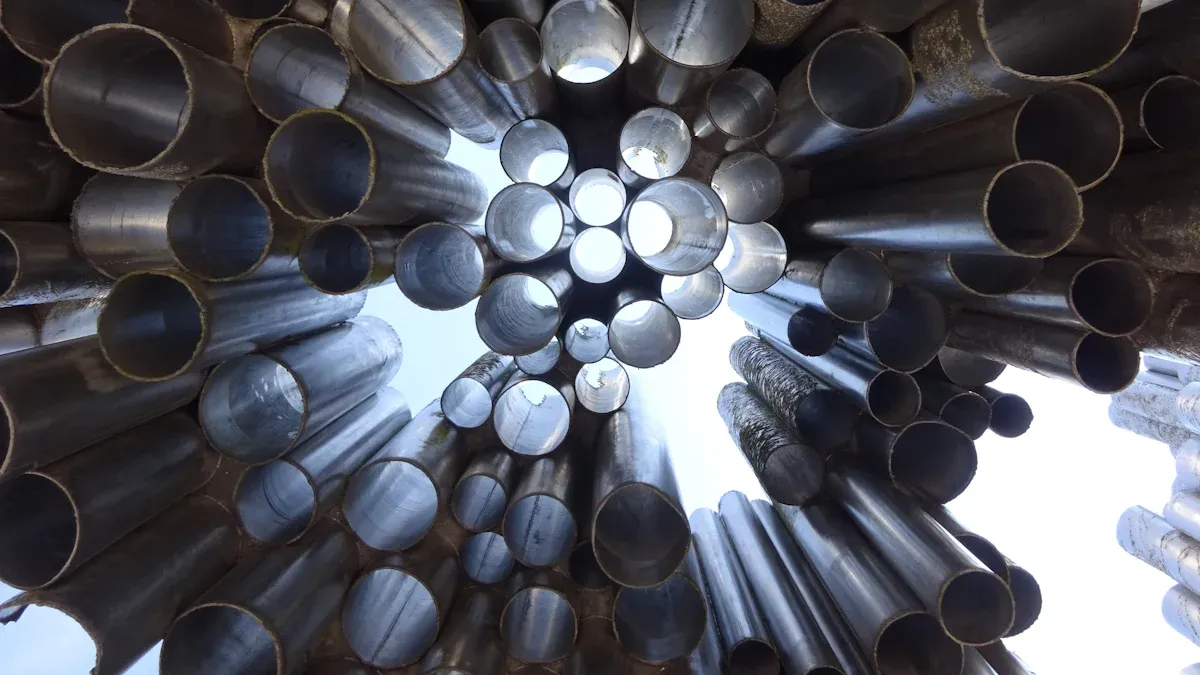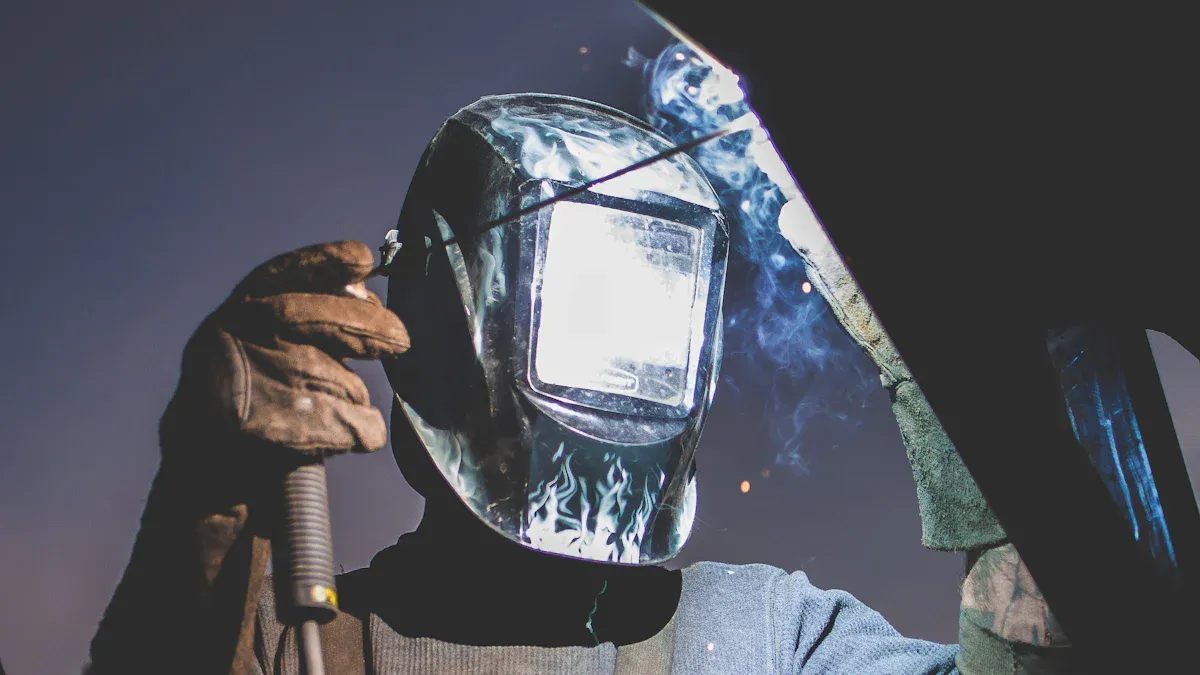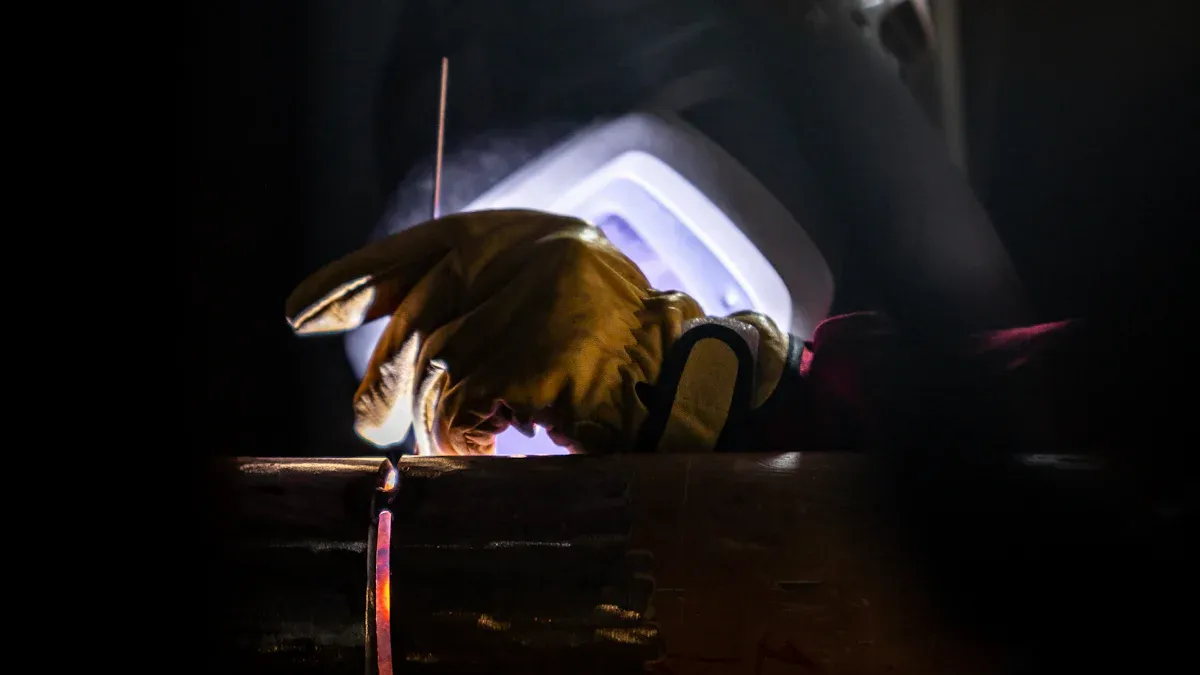Views: 0 Author: Site Editor Publish Time: 2025-07-21 Origin: Site









For hdpe extrusion welding, always use good and working equipment. Make sure your plastic surfaces are clean before you start extrusion. Set the right temperature for polyethylene and pick the correct nozzle for each plastic weld. Being clean and careful is just as important as the machine. Good welding training helps you learn extrusion and stop mistakes. Polyethylene works best when you follow new welding training and use tools made for hdpe. Every good weld begins with paying close attention. Many welding experts use these steps for plastic and polyethylene extrusion welding jobs.
Tip: Always look at your plastic rods and equipment before extrusion. Checking often helps stop problems with plastic or polyethylene.
Use clean tools that work well. Make sure your welding rods match your HDPE materials. This helps make strong welds that last a long time.
Clean the surfaces well. Remove dirt, oil, and old layers. This helps the plastic parts stick together better.
Set the right heat. Keep the speed and pressure steady when welding. This stops the joints from being weak or breaking.
Line up the pipes carefully. Heat the materials evenly before welding. This makes the weld stronger and stops leaks or spaces.
Always do test welds first. Check the seams closely for any problems. This helps you find mistakes early and get good results.

You need the right welding equipment for strong and reliable plastic welds. The Weldy Booster EX3 stands out as a top choice for professional extrusion. This tool gives you high output and steady heat, which helps you work faster on pipe and membrane jobs. The Booster EX3 has a Swiss-made hot air gun, a locking key for long welds, and a rotating handle for comfort. You can change the welding shoes quickly, so you spend less time setting up and more time working. Many experts use this tool for poly pipe welding and other welding applications because it delivers consistent results.
Always match your welding rods to your polyethylene sheets or pipes. Using rods made from the same polymer as your pipe or sheet gives you the best weld. For example, HDPE rods work best with HDPE sheets. This match helps you avoid weak seams and failures. You should also check the melt-flow index, density, and durability of your rods. Using rods from the same manufacturer as your pipe or sheet supplier is a smart move. Look at this table to see how different rod and sheet combinations affect weld strength:
| Material Combination | Welding Factor (Weld Strength / Base Material Strength) | Notes |
|---|---|---|
| Pure HDPE | ~1.1 | Weld bead often stronger than base material. |
| HDPE with blends (HDPE dominant) | ≥ 0.9 | High compatibility; weld strength close to base material. |
| HDPE with blends (PA12 dominant) | < 0.9 | Lower strength due to limited chain mobility. |
| PA12 with blends | ~0.65 - 1.0 | Strength varies; diffusion welding can help improve the bond. |
You get the best results when you use HDPE rods with HDPE pipes. This is true for both extrusion and butt welding. Poly pipe welding depends on this match for strong, lasting joints.
Keep your welding equipment clean and well-calibrated. Dirt or dust on your plastic or pipe can ruin a weld. Clean your nozzles and shoes before every job. Check your machine’s settings often. Calibration makes sure your extrusion temperature stays right for polyethylene. If you use your equipment for butt welding or poly pipe welding, regular checks help you avoid problems. Replace worn parts before they fail. Good maintenance keeps your plastic welds strong and your projects on track.
Tip: Clean your equipment after every use. This simple step helps you avoid contamination and keeps your pipe welds strong.
You need to start every hdpe extrusion welding job with a clean surface. Dirt, oil, and dust can weaken your welds. Use a lint-free cloth to wipe down the plastic. If you see grease or oily spots, use isopropyl alcohol to remove them. Never use harsh cleaners because they can damage the plastic. Always check the pipe for mud or debris before you begin. You can use a soft brush to remove loose dirt. For best results, clean both the pipe and the welding rod. This step helps you get a strong bond between the polyethylene parts.
Tip: Clean your tools and gloves before touching the pipe or plastic. This prevents new dirt from getting on your work.
Oxidation forms on polyethylene when it sits in the sun or air for a long time. This layer looks dull or white. You must remove it before welding. Use a sharp scraper or a rotary tool to shave off the top layer of the pipe. Make sure you remove all the white or faded plastic. Only weld on the fresh, shiny surface. If you skip this step, the weld will not hold. Always scrape the area where you plan to weld, even if the pipe looks clean. This step is very important for strong polyethylene welds.
Here is a simple checklist for surface prep:
Wipe the pipe and plastic with a clean cloth.
Remove all grease and oil.
Scrape away any oxidation.
Check for dust or debris before welding.
You get better results when you follow these steps every time. Clean surfaces help you make strong, lasting welds in every hdpe extrusion welding project.

You must set the right temperature for every extrusion weld. The correct temperature helps you get strong and reliable joints in plastic pipes. If you use too little heat, the plastic does not melt enough. If you use too much, the material can burn or weaken. For polyethylene, you should keep the heater plate temperature between 204 °C and 232 °C (400°F to 450°F) during butt welding. This range softens the pipe without causing damage.
For friction stir welding, the shoulder temperature matters a lot. Look at this table to see how temperature affects weld strength:
| Shoulder Temperature (°C) | Tensile Strength (MPa) | % of Base Material Strength |
|---|---|---|
| 120 | 13.1 ± 0.1 | 96% |
| 140 | 14.4 ± 0.2 | 105% |
| 160 | 11.8 ± 0.3 | 87% |
The best weld strength comes at 140 °C. At this setting, the weld can be even stronger than the base material. If you go above or below this temperature, the weld gets weaker. Always check your machine’s display and use a thermometer if needed. Consistent temperature control keeps your extrusion welds strong and helps you avoid costly repairs.
Tip: Always preheat your pipe and plastic parts evenly. This step helps you avoid cold spots and weak welds.
Speed matters in hdpe extrusion welding. If you move too fast, the plastic does not have time to melt and bond. If you go too slow, you risk overheating and burning the material. You should find a steady pace that lets the extrusion flow smoothly into the joint. Watch the bead as you weld. A good bead looks even and fills the gap between the pipe and the rod.
Here are some speed welding tips to help you:
Keep your hand steady and move at a constant rate.
Let the extrusion rod feed into the joint without forcing it.
Watch for signs of overheating, like smoke or discoloration.
Adjust your speed if you see gaps or uneven beads.
Operator skill plays a big role in welding quality. Studies show that the way you control speed and temperature affects the stress crack resistance of the weld. Good extrusion welds have much higher resistance to cracks than poor ones. Practice helps you find the best speed for each job.
Pressure is another key factor in extrusion and butt welding. You need enough pressure to press the melted plastic together, but not so much that you squeeze out too much material. Too little pressure leads to weak joints. Too much can cause defects or thin spots in the weld.
Environmental conditions also affect your results. Wet or cold weather can change how the pipe and plastic respond to heat and pressure. For example, freeze-thaw cycles and wetting can change the seam strength of polyethylene geomembranes. Some adhesives get stronger with wetting, while others get weaker. Seam width and thickness also matter. Wider seams often have better strength.
You should always check the work area before you start. Make sure the pipe and plastic are dry and at room temperature. Avoid welding in rain or extreme cold. If you must work outside, use covers or tents to protect your workspace.
Note: Operator control over pressure, temperature, and speed is critical. Small changes in these parameters can make a big difference in weld quality and long-term durability.
A good extrusion weld depends on your skill and attention to detail. When you set the right temperature, use steady speed, and apply proper pressure, you get strong, reliable joints in every pipe and plastic project.
You need to pay close attention to alignment before you start welding. Good alignment helps you create strong, even joints in every pipe project. If you line up the pipe ends carefully, you avoid gaps and uneven seams. Use clamps or guides to hold the pipe steady. Check that the ends meet at the right angles. This step matters for both extrusion and butt welding. When you fit the pipe together well, you get a smooth bead and fewer weak spots. Always double-check your setup before you begin. A small mistake in alignment can lead to leaks or joint failure later.
Tip: Mark your pipe with a straight line to help keep everything in place during welding.
Preheating the base material makes a big difference in weld quality. When you preheat HDPE at the right temperature, you boost the strength of your welds. Research shows that preheating joints at 260 °C can increase shear strength by more than nine times compared to joints that are not preheated. This means your welds hold up better under stress. However, if you use too much heat, like 550 °C, the plastic can melt too much and lose strength. You need to control the hot air temperature, movement speed, and nozzle distance. This helps you spread the heat evenly and avoid defects. Always aim for a steady, even preheat to get the best results in both extrusion and butt welding.
Set your hot air gun to the recommended temperature.
Move the nozzle slowly and evenly across the pipe surface.
Keep the nozzle at a safe distance to avoid overheating.
Uniform preheating helps you avoid cold spots and weak welds. You get stronger, more reliable joints every time.
Choosing the correct type of nozzle is key for successful extrusion. The nozzle shapes the flow of melted plastic and helps you direct it right into the joint. For poly pipe welding, you need a nozzle that matches the size and shape of your pipe. A good nozzle lets you control the bead and fill the gap without making a mess. If you use the wrong nozzle, you might get uneven welds or waste material. Always check your equipment before you start. Make sure the nozzle fits your pipe and the type of weld you plan to make. For butt welding and extrusion, the right nozzle helps you keep a steady bead and avoid overheating the plastic.
Note: Clean your nozzle before every job. Dirt or old plastic can block the flow and weaken your weld.
You get the best results when you match your nozzle to your pipe and keep your tools in top shape. This step helps you work faster and make stronger joints.

You should always perform test welds before starting your main project. Test welds help you check if your machine settings and technique will give you strong results. When you perform test welds, you can spot problems early and avoid weak joints in your final work. You can use different tests to measure the strength and quality of your weld seam.
Tensile tests show how much force your weld seam can handle before breaking.
Impact tests measure how well your weld seam stands up to sudden hits or drops.
Creep tests check how your weld seam holds up under stress over time.
Some labs remove layers from the weld seam to measure things like elastic modulus and yield strength. This helps you see if all parts of the weld seam are strong. You can also use thermal analysis and special models to predict how heat and pressure affect your welds. These steps help you control your process and get better results.
After you finish welding seams, you need to look closely at your work. Visual inspection is a simple but powerful way to find problems. You should check for smooth, even beads and make sure there are no gaps, cracks, or bubbles. The weld seam should look shiny and uniform. If you see dull spots or holes, you may need to adjust your technique.
Some advanced jobs use phased array ultrasonics to find hidden defects. This tool can spot problems inside the weld seam that you cannot see from the outside. It helps you make sure your welds are safe and strong.
Tip: Use a flashlight and magnifier to check your weld seam in hard-to-see areas.
Proper cooling is just as important as heating. You should let your weld seam cool down slowly and naturally. Fast cooling can cause cracks or weak spots. Do not touch or move the welded parts until the weld seam feels cool to the touch. If you rush this step, you risk damaging your hard work.
A good cooling process helps your weld seam reach its full strength. You get better results and longer-lasting joints when you follow the right cooling steps every time.
You can face many problems if you do not keep your work area clean during extrusion. Contamination is one of the most common hdpe extrusion welding problems. Dirt, dust, oil, or even small bits of old plastic can weaken your weld. You should always clean your tools, gloves, and the HDPE surfaces before you start. Use a lint-free cloth and check for any signs of grease or debris. Even a small amount of dirt can cause big problems in the weld seam.
Tip: Always store your welding rods in a clean, dry place. This helps you avoid problems with hdpe extrusion welding caused by dirty or wet rods.
You should also avoid touching the cleaned surfaces with bare hands. Oils from your skin can transfer to the plastic and create weak spots. If you see any contamination during extrusion, stop and clean the area again. This step helps you avoid problems and keeps your welds strong.
Weld movement during extrusion can lead to many problems. If the parts shift while you work, the weld bead may not form correctly. You might see gaps, uneven seams, or weak joints. To avoid these problems, always secure your pipes or sheets before you start. Use clamps, guides, or supports to hold everything in place.
A steady hand is important. Move the extruder at a constant speed and keep the nozzle close to the joint. If you rush or move too slowly, you can create more problems. Watch the weld bead as you go. If you notice any shifting, stop and realign the parts.
Here is a quick checklist to help you prevent weld movement:
Clamp the workpieces tightly.
Check alignment before starting extrusion.
Keep a steady pace and pressure.
Watch for any movement during welding.
By following these steps, you can avoid problems and get strong, reliable welds every time.
You can make strong HDPE extrusion welds by doing a few simple things. Always keep your work area clean. Set the right temperature before you start. Use equipment that works well and is not broken. Training is important, so practice welding often. Take welding classes to get better and make fewer mistakes. Learn about new tools and ways to weld by training more. Each time you train, you get safer and more confident.
Remember: Good welding training helps you do your best every time.
Electrofusion welding joins plastic pipes together. It uses special fittings that have wires inside. When electricity goes through the wires, they get hot. The heat melts the pipe and fitting so they stick together. This makes a strong joint that does not leak.
Electrofusion joins pipes using fittings and electricity. Extrusion welding joins plastic sheets or pipes by melting and adding more plastic. Electrofusion gives you joints that are exact and dependable. Extrusion welding is better for bigger seams or fixing things.
Electrofusion welding makes joints that are clean and strong. You can use it in small spaces. You do not need fire or flames. This method lowers the chance of leaks. It works for pipes that carry gas, water, or chemicals.
Electrofusion welding is mostly for polyethylene and some polypropylene pipes. Not every plastic works with this method. Always check what your pipe is made of before you start. Pipes made for electrofusion give the best results.
Wear gloves and eye protection every time. Check your tools and machine before you begin. Keep your work area neat and tidy. Follow the rules for your electrofusion welding machine. Do not touch hot fittings. Wait for the joint to cool before moving the pipe.
